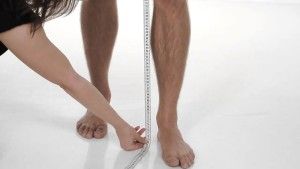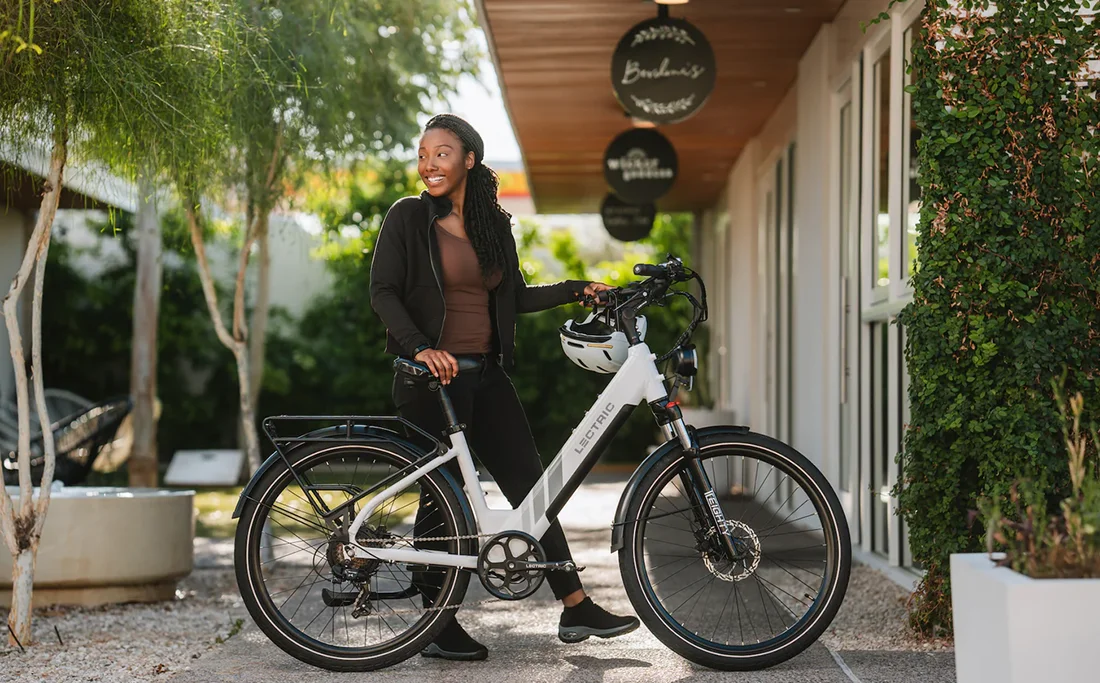Selecting the right bike size doesn’t have to be complicated. This guide breaks down how different bikes are measured. It also offers fitting tips for men, women and kids.
A professional fitting at a bike shop is always ideal. But not when you’re buying bikes online or through a marketplace.
So, if that’s not an option, use this guide to assess your needs and choose a suitable size.
If you want to jump straight to sizing, use the table of contents to find your section. If you’d rather get the full context and tips, read on for the complete guide.
Contents
What Size Bike Do I Need?
Bike sizing might seem tricky because there isn’t a universal system that works for every bike and every rider. Adult bikes are usually sized by frame, while kids’ bikes use wheel size, and road and mountain bikes follow their own standards.
A professional bike fitting at a local shop will give you the most accurate results. But if you’d rather start on your own, the charts and tips in this guide will help you narrow down the right size.
What and How to Measure
If you want to know what size bike frame do you need, you need two measurements: height and inseam.
Why inseam matters: it ensures the right standover height—you want 1–2″ clearance between your crotch and the top tube for comfort and safety.
What you need: tape measure, book, ~30 seconds.
- Height: stand against a wall, place a book on your head, measure floor to book.
- Inseam: shoes off, feet hip-width, measure from floor to crotch.
Write them down, and you’re ready to size your bike.
Is Women’s Bike Sizing And Different?
Some bicycle brands produce women-specific models, often with features like narrower handlebars, shorter stems, or saddles designed for female anatomy. These adjustments can improve comfort, but when it comes to sizing, there is no fundamental difference between men’s and women’s bikes.
Both use the same frame measurements, and the same charts apply to all adult riders. The key is to start with the correct frame size and then fine-tune the fit with components such as the saddle, stem, or handlebars.
This approach ensures women get just as precise and comfortable a fit as men, whether they choose a women-specific design or a standard model.
Differences in Bike Types
Bike sizing isn’t universal.
Sizing can differ between bike types and even from one brand to another.
Road bikes and mountain bikes often use different numbers for the same rider height, which can be confusing. In the past, sizes were based on frame parts like the seat tube.
As bike designs evolved, manufacturers updated their systems to match modern geometry.
The idea was to simplify things, but because some brands still use older methods, you’ll see mixed sizing standards today. Always check the chart for your specific bike style to make sure the fit is right.
Important Info About Bike Size Charts

The charts below cover road, mountain, hybrid, and kids’ bikes.
There’s no single chart that works for every brand or style, since each uses slightly different measurements.
Use these charts as a starting point to find your general size, then double-check with the brand’s own chart for the most accurate fit.
Each chart in this guide works as a simple bike size graph, helping you compare height, inseam, and frame size at a glance. So let’s start
Road / E-Road / Gravel / Adventure Bike Size Chart
Road, gravel, and adventure bikes all use centimeter-based frame sizing, and their charts overlap closely. While gravel and adventure frames may have slightly different geometry for stability and comfort, the starting point is the same as for road bikes. Use the chart below to match your height with the right frame size.
| Frame Size (cm) | Rider Height (ft/in) | Rider Height (cm) | Alpha Size |
|---|---|---|---|
| 47–48 cm | 4’10”–5’0” | 148–152 cm | XXS |
| 49–50 cm | 5’0”–5’3” | 152–160 cm | XS |
| 51–53 cm | 5’3”–5’6” | 160–168 cm | S |
| 54–55 cm | 5’6”–5’9” | 168–175 cm | M |
| 56–58 cm | 5’9”–6’0” | 175–183 cm | L |
| 58–60 cm | 6’0”–6’3” | 183–191 cm | XL |
| 61–63 cm | 6’3”–6’6” | 191–198 cm | XXL |
This gives you a good ballpark reference, but geometry can differ between brands, so it’s always worth checking the specific model chart for the best fit.
If you fall between two sizes, consider these tips:
Size up if:
- Your arms are long, or your wingspan is greater than your height
Size down if:
- You want a bike that feels lighter and stiffer (good for sprinters)
- You prefer a more upright riding position

MTB, E-MTB & Fatbike Size Chart
Don’t rely on S/M/L labels—they vary widely by brand.
Size mountain bikes by measurements: start with reach and stack, then confirm effective top tube and standover in the brand’s geometry chart.
Hardtails and full-suspension bikes can feel different at the same “size” (full-suspension often a touch shorter in feel due to suspension design and sag), so compare the numbers, not the letters. With modern geometries, tube lengths alone aren’t useful.
Use the chart below to match your bike size for height with the recommended mountain bike frame measurements, keeping in mind that geometry can differ slightly between brands and between hardtail and full-suspension models.
MTB, E-MTB & Fatbike Size Chart
| Frame Size (in) | Alpha Size | Rider Height (ft/in) | Rider Height (cm) | Leg Inseam (in) | Leg Inseam (cm) |
|---|---|---|---|---|---|
| < 14″ | XS | 4’10″–5’1″ | 148–158 cm | 24″–29″ | 61–73 cm |
| 15″–16″ | S | 5’1″–5’5″ | 158–168 cm | 25″–30″ | 63–76 cm |
| 16″–17″ | M | 5’5″–5’9″ | 168–178 cm | 26″–31″ | 66–78 cm |
| 17″–18″ | L | 5’9″–6’0″ | 178–185 cm | 27″–32″ | 68–81 cm |
| 18″–19″ | XL | 6’0″–6’3″ | 185–193 cm | 28″–33″ | 71–83 cm |
| 19″+ | XXL | 6’1″–6’6″ | 193–198 cm | 29″–34″ | 73–86 cm |
This gives you a good ballpark reference, but geometry can differ between brands, so it’s always worth checking the specific model chart for the best fit.
What About MTB Wheel Sizes?
Mountain bikes today come in three main wheel sizes: 26″, 27.5″, and 29″. The older 26″ size is now rare but still offers a very agile, playful feel for smaller riders. Most modern bikes use 27.5″ or 29″, and your choice depends on both height and riding style.
- Smaller riders often find 27.5″ wheels easier to handle and more responsive on twisty trails.
- Taller riders usually benefit from 29″ wheels, which improve stability, roll over obstacles smoothly, and keep speed better.
- 26″ wheels may still appeal to riders who want maximum maneuverability and quick handling, though they’re less common today.
In general, larger wheels provide smoother handling at speed and better efficiency, while smaller wheels favor sharp handling and agility. Beginners can safely follow the first option in the chart, while advanced riders might experiment with different sizes to match their style. The best way to judge handling for your height and skills is to test ride and compare.
When to Size Up or Down on a Mountain Bike
If you fall between two mountain bike sizes, think about your riding style.
- Size up if you want more stability at speed, better traction on climbs, or extra room in the cockpit.
- Size down if you prefer quicker handling, a more playful ride, or a slightly lighter bike for technical trails.
Geometry varies by brand, so always compare charts and, if possible, test ride both sizes to feel the difference.
Why Do Mountain Bikes Have So Many Specifics in Frame Measuring?
In the early days, MTBs were sized by seat tube length, which gave a fair idea of standover height.
That worked when frames were simple and close to road bike geometry. As designs changed—sloping top tubes, dropper posts, longer wheelbases—the seat tube stopped being a reliable guide.
Today, brands usually assign a frame size (XS, S, M, L, etc.), but these sizes don’t always match across companies. That’s why geometry charts list extra numbers like reach and stack. While you don’t measure these yourself at home, they let you compare how different bikes in the same “size” will actually feel.
Start with the frame size for your height and inseam, then use reach and stack to fine-tune which brand’s sizing works best for you.
Hybrid / E-Hybrid / City / Commuter Bike Size Chart
Hybrid bikes, such as commuters and fitness models, are versatile and usually budget-friendly.
Most brands list them in Small, Medium, or Large sizes, but some still use inches for frame measurements. Because sizing can vary, it’s best to check the geometry chart for each model.
Start with your height as a guide, then fine-tune the fit with adjustments like saddle height or stem length.
| Frame Size (in/cm + Alpha) | Rider Height | Leg Inseam |
|---|---|---|
| 14″ / ~47 cm — XS | 4’10″–5’1″ 147–155 cm | 24″–29″ 61–73 cm |
| 15″ / ~48 cm — S | 5’1″–5’5″ 155–165 cm | 25″–30″ 63–76 cm |
| 16″ / ~50 cm — M | 5’5″–5’9″ 165–175 cm | 26″–31″ 66–78 cm |
| 17″ / ~52 cm — L | 5’9″–6’0″ 175–183 cm | 27″–32″ 68–81 cm |
| 18″ / ~54 cm — XL | 6’0″–6’3″ 183–191 cm | 28″–33″ 71–83 cm |
| 19″ / ~56 cm — XXL | 6’3″–6’6″ 191–198 cm | 29″–34″ 73–86 cm |
Use this as a ballpark reference—geometry can vary across brands, so double-check specific model charts.
Size up when:
- You have long arms or legs and want more reach.
- You ride long distances and prefer a stretched, aerodynamic position.
- You want extra stability at higher speeds.
Size down when:
- You prefer a lighter, stiffer frame for sprinting.
- You like a more upright riding position.
- You want sharper handling for technical courses.
Kids & Junior Bike Size Chart
Kids’ bikes are sized by wheel diameter, which makes them easier to understand than adult bikes.
A 12-inch bike has 12-inch wheels, a 16-inch bike has 16-inch wheels, and so on. Height is the main factor, but age can be a useful guide too.
Always check that your child can stand over the frame comfortably and reach the handlebars and brakes with ease. Use the chart below as a starting point, then confirm the fit with an in-person test ride whenever possible.
| Tire Size | Age Range | Rider Height (ft/in) | Rider Height (cm) | Leg Inseam (in) | Leg Inseam (cm) |
|---|---|---|---|---|---|
| 10″ | 2 years | 2’9″–3’1″ | 85–90 cm | 12″–14″ | 30–35 cm |
| 12″ | 3–4 years | 3’1″–3’3″ | 90–100 cm | 14″–17″ | 35–42 cm |
| 14″ | 4–5 years | 3’3″–3’7″ | 100–110 cm | 16″–20″ | 40–50 cm |
| 16″ | 5–6 years | 3’7″–3’8″ | 110–115 cm | 18″–22″ | 45–50 cm |
| 18″ | 6–8 years | 3’8″–4’0″ | 115–120 cm | 20″–24″ | 50–60 cm |
| 20″ | 7–9 years | 4’0″–4’5″ | 120–135 cm | 22″–25″ | 55–63 cm |
| 24″ | 9–11 years | 4’5″–4’9″ | 135–145 cm | 24″–28″ | 60–72 cm |
| 26″ | 11–14 years+ | 5’0″+ | 145 cm+ | 28″+ | 72 cm+ |
This gives you a good ballpark reference, but geometry can differ between brands, so it’s always worth checking the specific model chart for the best fit.
What to Do if Your Child Is in Between Kids’ Bike Sizes
If your child sits between two sizes, consider:
- Growth: Sizing up can extend use, but only if they can touch the ground and reach the brakes.
- Confidence: Smaller bikes feel easier to handle, which helps new riders.
- Adjustability: Check seatpost and handlebar range—some bikes give room to grow without losing comfort.
Pick the bike your child feels safest and most confident on today.
What If I Got My Bike Size Wrong?
 Then ask your merchant, if you can send your bike back to get the right one. If you don’t want to do that, then you can do the following things:
Then ask your merchant, if you can send your bike back to get the right one. If you don’t want to do that, then you can do the following things:
- Move your saddle to the front or rear
- Buy a longer or shorter stem. It changes your body position
- Buy a longer seat post
Consider also: JensonUSA fitting guide
Give it time to get the feeling right. I remember when I got my first 29er mountain bike. It felt like a ship and seemed difficult to ride in narrow trails of the forest.
Frequently Asked Questions
What size push bike do I need?
Push bikes are typically sold with 10" - 14" wheels. A 10-inch push bike will usually fit kids aged 18 months to 2 years; a 12-inch push bike will fit kids aged 2-4 years; while a 14" push bike will typically fit kids aged 3-5 years old. These are just general recommendations—for the best fit, consider your child's inseam length.
What size bike do I need for my height?
To find out what size bike you need for your height, you should consult a sizing chart for the type of bike you're interested in, such as road, mountain, or hybrid. Depending on the type, bike size charts will match your height to a corresponding frame size denoted in centimeters, inches, or general sizes (XS, S, M, L, XL).
Is a 26-inch bike for adults?
A 26-inch bike can be suitable both for adults and for kids, depending on the context. Kids' 26-inch bikes are suitable for teenagers and shorter adults. However, some adult bikes, such as touring bikes, fat bikes or electric bikes, also come with 26-inch wheels, but these have larger frames and are not suitable for children.
What height is a 26-inch bike good for?
A kids' 26-inch bike (a bike with 26-inch wheels) is typically suitable for teenagers and shorter adults who are around 5'0" to 5'3" tall. However, bikes for adults with 26-inch wheels, such as fat bikes or some electric bikes, are often available in a few frame sizes and might fit adults who are 6 feet in height and taller.
How do I know if a bike is too big or too small?
A bike is considered too big if you cannot stand over the frame with both feet flat on the ground without the top tube touching your crotch, or if you have to stretch too far forward to reach the handlebars. Conversely, it's considered too small if you feel cramped when riding, can't adjust the seat high enough, or your knees hit the handlebars when pedaling.
___ Inch bike for what size person?
To determine which bike size is suitable for a particular height range, consult a specialized bike size chart for the bike type you're interested in, such as our road, mountain, and hybrid size charts above. These charts match rider heights with appropriate bike sizes, allowing you to get a proper fit.





This blog post hit all the right notes!
It’s always a joy to stumble upon content that genuinely makes an impact and leaves you feeling inspired. Keep up the great work!
Thank you for the amazing blog post!